Discovery Dashboard
Chellie Esters
Lamont Eddins
The Discovery dashboard allows you to establish trends within your facilities operations by comparing monthly data on work orders, invoices, and providers from the current year to that of the year prior. This dashboard empowers you to analyze your year-over-year facilities spending trends. You can also analyze the health of your facilities management operations by comparing data on recalls, feedback, committed spend, and provider performance.
Discovery is comprised of the following sections:
You will see all data for the past 3 completed months (by default) or by the criteria set in the all-inclusive filters along the top of the report.
You can download the data and email reports to recipients.
Program Highlights

Under Program Highlights, you can analyze information pertaining to:
- Number of WOs
- Number of Proposals
- Number of Invoices
- Invoice Amount
- Average Invoice Amount
- Average Full Resolution Time (Days)
- Active Locations
★ An example on how to read Program Highlights data

This is an example of the Invoice Amount metric.
- For the time period selected in the filter (in this case, January 2020 - March 2020), the total Invoice Amount across all locations is $40,307 USD.
- This is a 730% increase from the same time period last year.
- The increase amounts to $35,450 USD.
The number listed above the label statistical components represents the corresponding figure for the “Selected Period” which is, again, one of the global filters found at the top of this dashboard.
Work Orders Created and Completed, Year Over Year
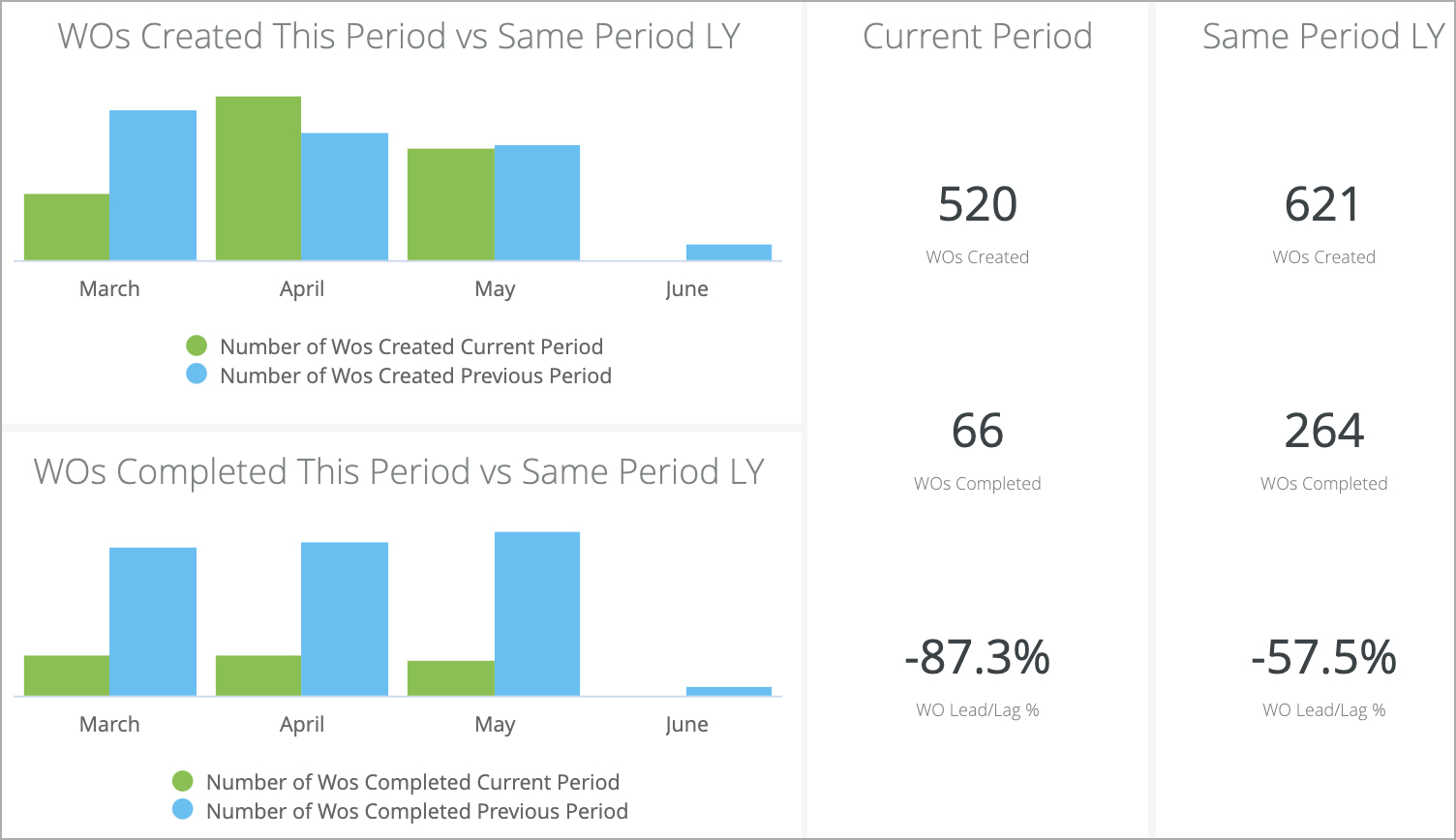
This group of visualizations compares work orders that were created or completed in the current year with the volume from last year, and the variance.
Here you will see:
- Work Orders Created This Period vs Same Period Last Year: side-by-side visualization and figures
- Work Orders Completed This Period vs Same Period Last Year: side-by-side visualization and figures
- WOs Lead/Lag %, Current Period vs Same Period Last Year: these figures show work order completion trends during the current and previous periods, calculated as
(Completed Work Orders - Created Work Orders) ÷ All Created Work Orders.
Both voided work orders and work orders with an empty Status are excluded.
Top 5 Locations by Variance

This table displays the Invoice Amount for Invoices posted during the current period and Invoice Amount Variance in % and $ between the current period and the previous one (top 5 Locations by Absolute Invoice Amount Variance).
- Variance in % is calculated as a difference between the current period Invoice Amount and the previous period Invoice Amount divided by the previous period Invoice Amount.
- Variance in $ is calculated as a difference between the current period Invoice Amount and the previous period Invoice Amount.
Should your company have a specific location that spends a particularly large amount, it can be easily identified using this visualization.
For these five locations, you can see the current Period’s Invoice Amount, the change in Invoice Amount with respect to the same period of the prior year, and the corresponding percentage of that dollar amount.
Committed Spend vs Invoiced Amounts and Year-Over-Year Invoice Comparisons
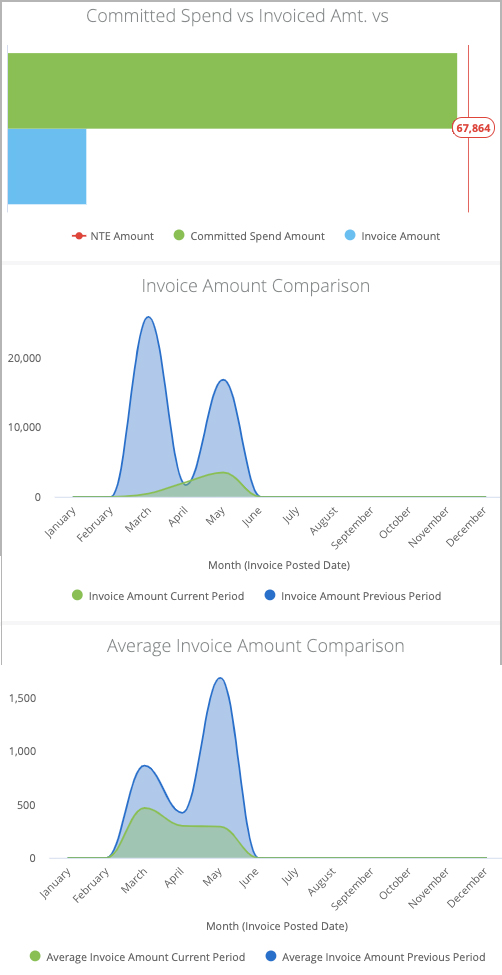
This group of visualizations illustrates how well your company is doing at staying within its budget.
Committed Spend vs Invoiced Amt. vs NTE represents progress towards a goal. You are ideally looking for the Committed Spend Amount to be less than the total NTE amount. It is a SUM of MAX NTE for WOs created in this Period. The progress is presented as two horizontal bars: Invoice Amount and Committed Spend Amount. Invoice Amount is a SUM of all Invoices for WOs created in this Period. Committed Spend Amount is a SUM of:
- Invoice Amount in case Invoice has "Approved" or "Paid" Invoice Status OR NTE Amount in case Invoice has "Open" or "On Hold" Invoice Status for WOs created in this Period;
- NTE Amount for non-invoiced WOs created in this Period
Below this are the Invoice Amount Comparison and the Average Invoice Amount Comparison visualizations, which both illustrate the Invoice Amounts of the pre-determined period compared to the same time frame last year. These visuals enable you to identify any trends related to Invoice Amounts, for example, did the average invoice amount increase for the same months of both this year and last?
Recalls and Feedback

Here, you want to see a decrease in both the number of Recalls as well as Unsatisfactory Feedback, while you will want to see an increase in the quantity of excellent & satisfactory feedback.
Recalls consist of the following data points:
- the number of Recalled Work Orders for the current period (or selected period)
- the number of Recalled Work Orders Variance, and
- the number of Recalled Work Orders Variance in % between the current period and last year.
- Variance in % is calculated as a difference between the current period Number of Work Orders and the previous period Number of Work Orders divided by the previous period Number of Work Orders.
- Variance (#) is calculated as a difference between the current period Number of Work Orders and the previous period Number of Work Orders.
Feedback Analysis consists of a similar structure as Recalls:
- The Excellent and Satisfactory metric is calculated as:
- the number of Work Orders with Excellent and Satisfactory Feedback Results for the current period (or selected period),
- the number of such Work Orders Variance, and
- the number of such Work Orders Variance in % between the current period and last year.
- Variance in % is calculated as a difference between the current period Number of Work Orders and the previous period Number of Work Orders divided by the previous period Number of Work Orders.
- Variance (#) is calculated as a difference between the current period Number of Work Orders and the previous period Number of Work Orders.
- The Unsatisfactory Feedback metric is calculated as:
- the number of Work Orders with Unsatisfactory Feedback Results for the current period (or selected period),
- the number of such Work Orders Variance, and
- the number of such Work Orders Variance in % between the current period and last year.
Variance in % is calculated as a difference between the current period Number of Work Orders and the previous period Number of Work Orders divided by the previous period Number of Work Orders.
Variance (#) is calculated as a difference between the current period Number of Work Orders and the previous period Number of Work Orders.
Top 5 Categories / Trades / Providers by Variance
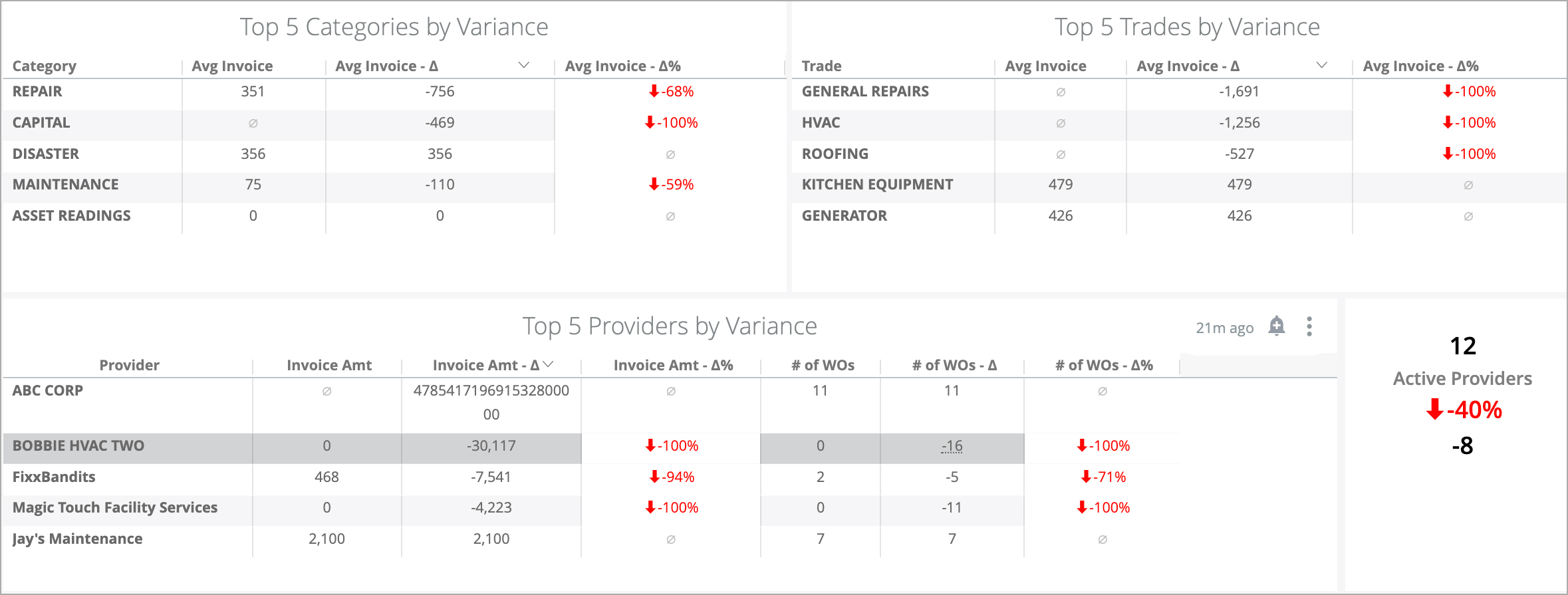
- Top 5 Categories by Variance: This table shows the Average Invoice Amount for Invoices posted during current period and Average Invoice Amount Variance in % and $ between the current period and the previous one (top 5 Categories by Absolute Avg Invoice Variance).
- Variance in % is calculated as a difference between the current period Average Invoice Amount and the previous period Average Invoice Amount divided by the previous period Average Invoice Amount.
- Variance in $ is calculated as a difference between the current period Average Invoice Amount and the previous period Average Invoice Amount.
- Top 5 Trades by Variance: This table shows the Average Invoice Amount for Invoices posted during current period and Average Invoice Amount Variance in % and $ between the current period and the previous one (top 5 Trades by Absolute Avg Invoice Variance).
- Variance in % is calculated as a difference between the current period Average Invoice Amount and the previous period Average Invoice Amount divided by the previous period Average Invoice Amount.
- Variance in $ is calculated as a difference between the current period Average Invoice Amount and the previous period Average Invoice Amount.
- Top 5 Providers by Variance: This table displays the Invoice Amount for Invoices posted during current period, Invoice Amount Variance in % and $ between the current period and the previous one, Number of Work Orders for the Selected Period (current period), Number of Work Orders Variance and Number of Work Orders Variance in % between the current period and the previous one (top 5 Providers by Absolute Invoice Amount Variance).
- Variance in % is calculated as a difference between the current period value and the previous period value divided by the previous period value.
- Variance in $ is calculated as a difference between the current period value and the previous period value.
- Active Providers: This metric consists of Number of Providers for the Selected Period (current period), Number of Providers Variance and Number of Providers Variance in % between the current period and the previous one.
- Variance in % is calculated as a difference between the current period Number of Providers and the previous period Number of Providers divided by the previous period Number of Providers.
- Variance is calculated as a difference between the current period Number of Providers and the previous period Number of Providers.
Commonly Used Features
Below is a quick reference guide regarding tracking numbers in Analytics, filtering, sorting, downloading data, and sending reports.
Tracking Numbers in Analytics
Throughout Analytics you can drill down into visualizations to see the underlying data. In most cases, the tracking numbers related to that data are listed. You can click the tracking number to navigate straight to the work order details in Service Automation.
Filtering Dashboards
On top of the report are all-inclusive filters to help you hone in on key data. All reports on the page are affected by the criteria set in these all-inclusive filters.
The filter criteria for each dashboard may differ. Filters reset to the default when the page is refreshed.
Click filter field to show the criteria.

Select the desired criteria to include or exclude:
To Include criteria: select is equal to, contains, starts with, or ends with, and then begin typing the criteria in the picklist. Select the desired criteria (or multiple criteria) from the picklist.
To exclude criteria: select is not equal to, does not contain, does not start with, or does not end with.
Is null depicts the absence of data in a data set. Conversely, is not null depicts the presence of data
To include or exclude data without a certain data criteria — for example, to select data without a Region or District assigned in Service Automation — choose is blank / is not blank.
To add more options, click the plus sign (+) next to a field to add another option to the filter. The new option will appear as either an OR condition or an AND condition, depending on the type of filter option.
Once all criteria are selected, click Refresh icon in the top-right corner. The Dashboard report updates with the selected criteria.
More details are available on Filtering an Analytics Dashboard
Dynamic Table Sorting
Analytics tables are dynamic, as you can:
- click column and row headers to sort data (the arrow indicate which data is sorted),
- hover over a header to show the gear icon where you can interact with the data more dynamically, and
- drag and drop a header to rearrange the table.
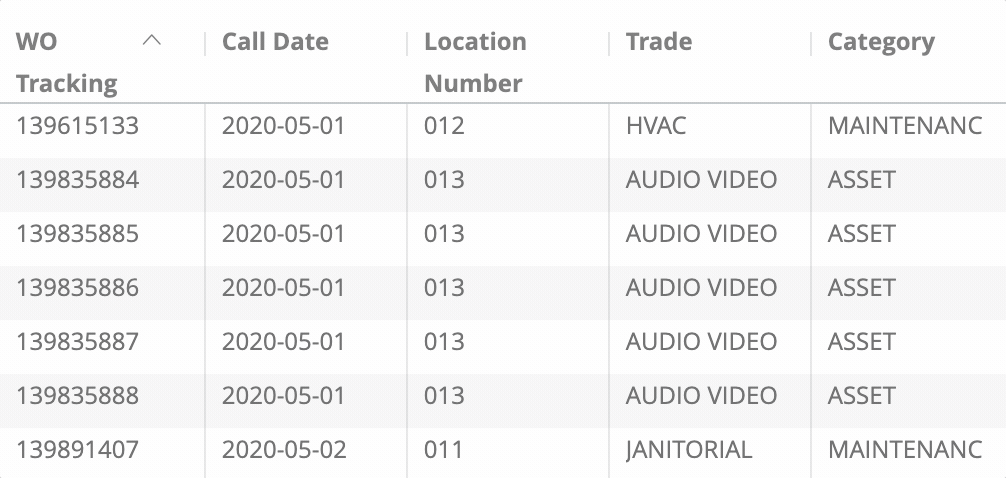
Downloading and Sending Reports
In the upper-right corner of any page, click the Vertical Ellipses to download reports, schedule delivery of reports at regular intervals, add to a board, or get a link.
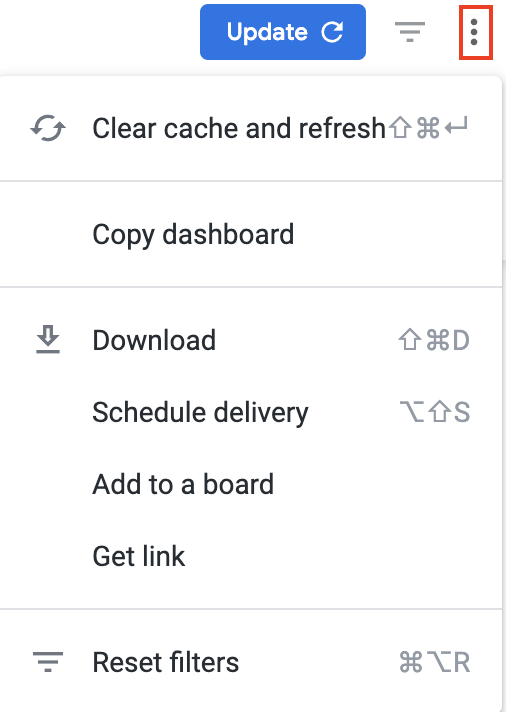
You can download data from a table and visualization or download a dashboard tabto PDF or CSV.
- On the desired table or visualization, hover over the upper-right to expose the 3 dots menu, and then click Download Data. The Download modal appears.

Select the desired File Format and choose a File Name: A default name is listed but you can change it.
- Click Download.
On the desired dashboard (or dashboard tab), click the Gear icon in the upper-right of the page, and then click Download as PDF. The Download modal appears.
A default Filename appears, but you can change it.
Under Advanced options:
Single-column format lays out all tables and visualizations on a page into one column in the PDF, as opposed to how it is laid out in the dashboard.
Expand tables shows all rows in a table, instead of just the rows that appear on the dashboard.
Paper size adjusts the PDF to your desired size.
Click Open in Browser to view the PDF in your chosen browser, or click Download to save a version of the report onto your device.
On the desired dashboard (or dashboard tab), click the Gear icon in the upper-right of the page, and then click Download as CSVs... A new browser tab opens.
After the files render, you are prompted to save the CSV Zip file onto your device.
More details are available on Downloading and Sending Dashboards and Reports
You can also Send a one-time report via email or Schedule a recurring email send.
On the desired dashboard (or dashboard tab), click the Gear icon in the upper-right of the page, and then click Send. The Send (Dashboard Name) modal opens.
A Title is given by default, but you can change it.
Under Who should it be emailed to?, enter the desired recipient(s), separated by a comma, and then click Add.
(Optional) Click Include a custom message to add a personal note.
Under Format data as, choose PDF, Visualization, or CSV Zip file.
(Optional): Click Filters to limit the criteria that appear in the email. Note that the same filters on the dashboard itself will also appear here.
Click Send. The email is sent to your recipients.
On the desired dashboard (or dashboard tab), click the Gear icon in the upper-right of the page, and then click Schedule. The Schedule (Dashboard Name) modal opens.
A Title is given by default, but you can change it.
Under Who should it be emailed to?, enter the desired recipient(s), separated by a comma, and then click Add.
(Optional) Click Include a custom message to add a personal note.
Under Format data as, choose PDF, Visualization, or CSV Zip file.
Under Deliver this schedule, choose Daily, Weekly, Monthly, Hourly, or By minute (in 5-minute increments, up to 30 minutes)
(Optional): Use Filters to limit the criteria that appear in the email. Note that the same filters on the dashboard itself will also appear here.
Click Send. The email is sent to your recipients.
More details are available on Downloading and Sending Dashboards and Reports
-
Page:
-
Page:
-
Page:
-
Page:
-
Page:
-
Page:
-
Page:
-
Page: